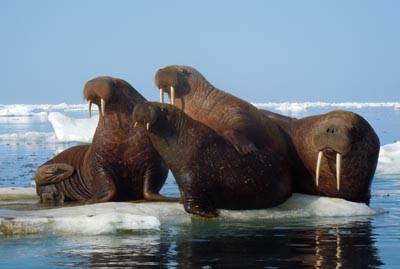
The research, titled "Drivers and Hotspots of Extinction Risk in Marine Mammals" and published in the latest Early Edition of the journal Proceedings of the National Academy of Sciences USA, shows that almost 40 percent of marine mammals are predicted to be at risk of extinction.
"This finding is particularly important because currently only 25 percent of marine mammals are recognized as at risk, according to International Union for the Conservation of Nature (IUCN) Red List - the global endangered species list," said lead author, Dr. Ana Davidson, postdoctoral researcher of Biology at the University of New Mexico and the Universidad Nacional Autónoma de Mexico. "The consequences of escalating human impacts on marine mammal biodiversity are poorly understood, largely because many marine mammals are difficult to study due to the remote nature of their environments."
The conservation status of nearly 40 percent of marine mammal species is unknown due to lack of information. Using powerful predictive models to predict the conservation status for these and other marine mammal species not currently known to be at risk, the researchers found that 37 percent of marine mammal species are at risk of extinction.
"The models are important for developing conservation priorities, and although they have been generated for terrestrial mammals, this is the first time they have been developed and utilized for marine mammals at the global scale," said Davidson.
In addition to the 32 species already on the Red List, the researchers, using their model, identified 15 more species as at risk. This is a considerable number given there are only 128 known species of marine mammals. Their model predicted about one-third of all species that are currently lacking a conservation status under the Red List, as at risk of extinction.
"One of these is the Amazon River Dolphin, who, like other river dolphins, faces intense human pressures from pollution, fishing and damming, including Brazil's recently approved Belo Monte hydroelectric dam, which will be the third largest in the world," said Davidson.
The walrus was another species the team determined to be at risk.
"Walruses are highly threatened by ocean warming, which is reducing sea ice used for breeding, feeding, and resting, and leading to increased shipping traffic, pollution and development," emphasized Davidson.
Davidson and her colleagues found that marine mammal species that are most likely to be at risk of extinction are those that have slow rates of reproduction.
Dr. Jim Brown, Distinguished Professor of Biology at UNM, said this is because the rate of reproduction reflects the, "capacity of a species to rebound from human impacts."
These results suggest that when species with high productivities fail to rebound rapidly after protection, the original environmental threats have not been alleviated or new ones, such as climate change, have arisen to inhibit recovery.
"For example, northern elephant seals have increased exponentially after protection," said Dr. Dan Costa of University of California, Santa Cruz. "They had been reduced to 20-30 individuals by 1900, but increased at an estimated 8.3 percent per year to a population of ~170,000 today."

mammal extinction risk. + or – indicates the direction of correlation , for the continuous variables. Drawings by Sharyn Davidson.">
But added Davidson, "species' traits were the most important predictors of risk overall, underscoring the importance of understanding species' basic biologies and ecologies, which is unfortunately lacking for many marine mammals, even some of the most well-known groups like dolphins."
Using their predictive model, the team also generated new maps of species at risk. They illustrate that at-risk species mostly occur in coastal regions and in productive areas of the open ocean, which are also areas subject to high levels of human impact. The models identified 13 global hotspots where high numbers of at-risk species occur, and show how they overlap with leading human impacts on the world's oceans (fishing, shipping and pollution, and climate change) and Marine Protected Areas.
"We found that three-quarters of marine mammal species experience high levels of human impact in their environment, and these include the cumulative effects of numerous factors, including fishing, shipping, pollution, sea surface temperature change, ocean acidification, invasive species, oil rigs, and human population density," said Dr. Alison Boyer, a researcher from the University of Tennessee.
Davidson hopes their work can help inform international efforts currently underway to expand Marine Protected Areas throughout the globe. Currently, only less than one percent (0.7) of the world's oceans are protected.
"New technologies are beginning to provide new and better data on both the biology of marine mammals and the ecology of the oceans, and that such information is essential for conservation and management to mitigate the threats facing many species," said Davidson.
The researchers conclude that because of the large magnitude and spatial scale of anthropogenic impacts and the wide ranges of many species, conservation of marine mammals will require unprecedented global effort and political will.
Other researchers involved in the project include Hwahwan Kim University of West Georgia, Marcus Hamilton of the Santa Fe Institute and UNM, and Dr. Gerardo Ceballos and Ph.D. student Sandra Pompa of UNAM.
To view the PNAS article visit: Drivers and Hotspots of Extinction Risk in Marine Mammals.
Media Contact: Steve Carr (505) 277-1821; email: scarr@unm.edu